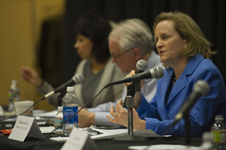What stories? Whose perspective?

How can museums preserve and create ideas and identity in a digital and global age? An internationally known panel of museum professionals, philosophers and artists recently discussed this challenging topic in the Amilcar Cabral Center at Northeastern University.
“While we’re all stakeholders in this question in so far as museums do represent what we are and what should matter to us, it is very rare to have an opportunity to be behind the scenes in the conversations that determine those directions,” said Carla Kaplan, founding director of Northeastern’s Humanities Center.
The panel discussion — “Museums and the World: Whose Story Is It?” — was held April 14 and cosponsored by The Humanities Center and the University of Southern California’s International Museum Institute. It also follows the recent opening of the Art of the Americas wing at Boston’s Museum of Fine Arts.
Elliot Bostwick Davis, the Art of the America’s John Moors Cabot Chair, called it an ambitious collection that not only includes many Anglo-American objects produced in Boston, but also represents North, Central and South American works from a wide range of artists — including Native Americans, Latin Americans, Spanish colonial artists and women.
“We hope this will help flesh out the many stories of the Americas,” she said.
How museums tell these stories was a central theme of the discussion. Selma Holo, professor of art history at the University of Southern California, said many challenges lie ahead, such as how the stories told by Holocaust museums will retain their vitality for people who were not directly affected.
New York City-based artist Fred Wilson, a MacArthur Foundation “Genius Grant” recipient and Whitney Museum Trustee, suggested museums establish more designated areas for focused conversations about particular topics, or even juxtapose objects from different collections to highlight the differences between cultures.
Richard Koshalek, director of the Smithsonian’s Hirshhorn Museum and Sculpture Garden in Washington, D.C., said the museum plans to transform its lobby into an interactive “classroom of the future,” while a nearby giant pavilion hosts discussions of educational, cultural and global importance.
“If we are going to be truly global institutions and have a global conversation, then we’ve got to bring the world together,” he said.
Speaking to the role of technology, Davis noted that the MFA’s collections can be viewed online and discussed through real-time blogs. Louisa McCall, codirector of the Cambridge, Mass.-based nonprofit Artists in Context, wondered about developing virtual collections that extend the meaning and context of a physical object.
Koshalek said while technology offers great potential, museum galleries’ “sacred space” must be preserved.





